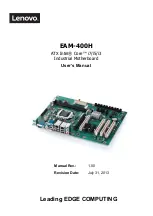
7. BIOS Setup
SPI-8550-LLVAS
55
I/O Features
Main Advanced Security Power PC_Health Boot Exit
IO Features
Serial port A:
[Enabled]
Base I/O address:
[3F8]
Interrupt:
[IRQ 4]
Serial port A:
[Enabled]
Base I/O address:
[2F8]
Interrupt:
[IRQ 3]
Parallel port:
[Enabled]
Mode:
[ECP]
Base I/O address:
[378]
Interrupt:
[IRQ 7]
DMA channel:
[DMA 3]
Floppy disk controller:
[Enabled]
Figure 7.11. IO Features Window (Factory Settings)
The CPU communicates with external devices such as printers through devices called Input/Output (I/O)
ports such as serial and parallel ports. Theses I/O devices require the use of system resources such as I/O
addresses and interrupt lines. If these devices are Plug and Play, either the BIOS can allocate the devices
during POST, or the operating system can do it. If the I/O devices are not Plug and Play, they may
require manually setting them in Setup.
On some systems, the chipset manages the communication devices. Other systems have, instead, a
separate I/O chip on the CPU board for configuring and managing these devices.
Use the following chart to configure the Input/Output settings:
Feature Options
Description
Serial port A:
Serial port B:
Disabled
Enabled
Disabled turns off the port.
Enabled requires you to enter the base Input/Output address and
the Interrupt number on the next line.
Serial port A : SERILA1, Serial port B : SERIAL2
Base I/O Address /
IRQ
3F8, IRQ4
2F8, IRQ3
If you select Enabled, choose one of these combinations.
Parallel Port:
Disabled
Enabled
Disabled turns off the port
Enabled requires you to enter the base Input/Output address and
the Interrupt number below.
Содержание SPI-8550-LLVAS
Страница 7: ...vi SPI 8550 LLVAS...
Страница 13: ...1 Introduction 6 SPI 8550 LLVAS...
Страница 19: ...2 System Reference 12 SPI 8550 LLVAS...
Страница 47: ...4 Jumper Setting 40 SPI 8550 LLVAS...
Страница 51: ...6 Hardware Monitor 44 SPI 8550 LLVAS...















































